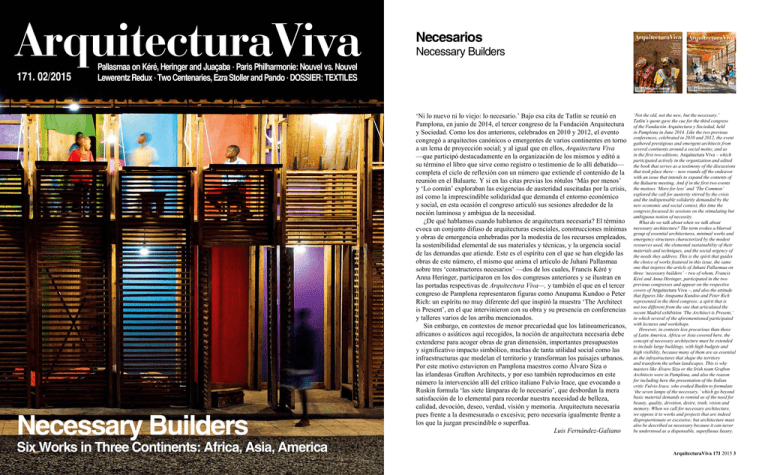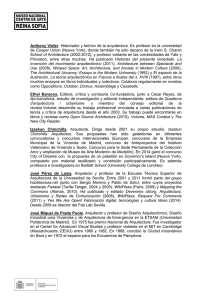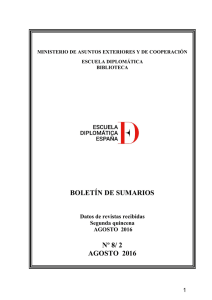Necessary Builders - Arquitectura Viva
Anuncio

ArquitecturaViva 171. 02/2015 Necesarios Necessary Builders Pallasmaa on Kéré, Heringer and Juaçaba · Paris Philharmonie: Nouvel vs. Nouvel Lewerentz Redux · Two Centenaries, Ezra Stoller and Pando · DOSSIER: TEXTILES Necessary Builders Six Works in Three Continents: Africa, Asia, America ‘Ni lo nuevo ni lo viejo: lo necesario.’ Bajo esa cita de Tatlin se reunió en Pamplona, en junio de 2014, el tercer congreso de la Fundación Arquitectura y Sociedad. Como los dos anteriores, celebrados en 2010 y 2012, el evento congregó a arquitectos canónicos o emergentes de varios continentes en torno a un lema de proyección social; y al igual que en ellos, Arquitectura Viva —que participó destacadamente en la organización de los mismos y editó a su término el libro que sirve como registro o testimonio de lo allí debatido— completa el ciclo de reflexión con un número que extiende el contenido de la reunión en el Baluarte. Y si en las citas previas los rótulos ‘Más por menos’ y ‘Lo común’ exploraban las exigencias de austeridad suscitadas por la crisis, así como la imprescindible solidaridad que demanda el entorno económico y social, en esta ocasión el congreso articuló sus sesiones alrededor de la noción luminosa y ambigua de la necesidad. ¿De qué hablamos cuando hablamos de arquitectura necesaria? El término evoca un conjunto difuso de arquitecturas esenciales, construcciones mínimas y obras de emergencia enhebradas por la modestia de los recursos empleados, la sostenibilidad elemental de sus materiales y técnicas, y la urgencia social de las demandas que atiende. Este es el espíritu con el que se han elegido las obras de este número, el mismo que anima el artículo de Juhani Pallasmaa sobre tres ‘constructores necesarios’ —dos de los cuales, Francis Kéré y Anna Heringer, participaron en los dos congresos anteriores y se ilustran en las portadas respectivas de Arquitectura Viva—, y también el que en el tercer congreso de Pamplona representaron figuras como Anupama Kundoo o Peter Rich: un espíritu no muy diferente del que inspiró la muestra ‘The Architect is Present’, en el que intervinieron con su obra y su presencia en conferencias y talleres varios de los arriba mencionados. Sin embargo, en contextos de menor precariedad que los latinoamericanos, africanos o asiáticos aquí recogidos, la noción de arquitectura necesaria debe extenderse para acoger obras de gran dimensión, importantes presupuestos y significativo impacto simbólico, muchas de tanta utilidad social como las infraestructuras que modelan el territorio y transforman los paisajes urbanos. Por este motivo estuvieron en Pamplona maestros como Álvaro Siza o las irlandesas Grafton Architects, y por eso también reproducimos en este número la intervención allí del crítico italiano Fulvio Irace, que evocando a Ruskin formula ‘las siete lámparas de lo necesario’, que desbordan la mera satisfacción de lo elemental para recordar nuestra necesidad de belleza, calidad, devoción, deseo, verdad, visión y memoria. Arquitectura necesaria pues frente a la desmesurada o excesiva; pero necesaria igualmente frente a los que la juzgan prescindible o superflua. Luis Fernández-Galiano ‘Not the old, not the new, but the necessary.’ Tatlin’s quote gave the cue for the third congress of the Fundación Arquitectura y Sociedad, held in Pamplona in June 2014. Like the two previous conferences, celebrated in 2010 and 2012, the event gathered prestigious and emergent architects from several continents around a social motto; and as in the first two editions, Arquitectura Viva – which participated actively in the organization and edited the book that serves as a testimony of the discussions that took place there – now rounds off the endeavor with an issue that intends to expand the contents of the Baluarte meeting. And if in the first two events the mottoes ‘More for less’ and ‘The Common’ explored the call for austerity stirred by the crisis and the indispensable solidarity demanded by the new economic and social context, this time the congress focussed its sessions on the stimulating but ambiguous notion of necessity. What do we talk about when we talk about necessary architecture? The term evokes a blurred group of essential architectures, minimal works and emergency structures characterized by the modest resources used, the elemental sustainability of their materials and techniques, and the social urgency of the needs they address. This is the spirit that guides the choice of works featured in this issue, the same one that inspires the article of Juhani Pallasmaa on three ‘necessary builders’ – two of whom, Francis Kéré and Anna Heringer, participated in the two previous congresses and appear on the respective covers of Arquitectura Viva –, and also the attitude that figures like Anupama Kundoo and Peter Rich represented in the third congress: a spirit that is not too different from the one that articulated the recent Madrid exhibition ‘The Architect is Present,’ in which several of the aforementioned participated with lectures and workshops. However, in contexts less precarious than those of Latin America, Africa or Asia covered here, the concept of necessary architecture must be extended to include large buildings, with high budgets and high visibility, because many of them are as essential as the infrastructures that shape the territory and transform the urban landscapes. This is why masters like Álvaro Siza or the Irish team Grafton Architects were in Pamplona, and also the reason for including here the presentation of the Italian critic Fulvio Irace, who evoked Ruskin to formulate ‘the seven lamps of the necessary,’ which go beyond basic material demands to remind us of the need for beauty, quality, devotion, desire, truth, vision and memory. When we call for necessary architecture, we oppose it to works and projects that are indeed disproportionate or excessive; but architecture must also be described as necessary because it can never be understood as a dispensable, superfluous luxury. ArquitecturaViva 171 2015 3 Arquitectura Viva.com 171. 02/2015 Necesarios Director Luis Fernández-Galiano Director adjunto José Jaime S. Yuste Diagramación y redacción Cuca Flores Eduardo Prieto Laura Fernández Miguel Fernández-Galiano Maite Báguena Raquel Vázquez Jorge Martín Pablo Canga Miguel de la Ossa Alicia Gutiérrez Mar Pérez-Ayala Coordinación editorial Laura Mulas Gina Cariño Producción Laura González Jesús Pascual Administración Francisco Soler Suscripciones Lola González Distribución Mar Rodríguez Publicidad Cecilia Rodríguez Teresa Maza Redacción y administración Arquitectura Viva SL Aniceto Marinas, 32 E-28008 Madrid Tel: (+34) 915 487 317 Fax: (+34) 915 488 191 [email protected] www.ArquitecturaViva.com Precio: 15 euros © Arquitectura Viva Esta revista recibió una ayuda a la edición del Ministerio de Educación, Cultura y Deporte en 2014 Depósito legal: M. 17.043/1988 ISSN: 0214-1256 Distribución en quioscos: Logintegral Impresión: Artes Gráficas Palermo, S.L. Cubierta: Orkidstudio, Nakuru Project, © Odysseas Mourtzouchos. Traducciones: E. Prieto (Pallasmaa, Žižek); L. Mulas, G. Cariño (inglés). Nota: El texto de Slavoj Žižek es un extracto del libro Events (publicado en español como Acontecimiento por la Editorial Sexto Piso). En breve. Nouvel carga contra la inauguración de la Philharmonie de París; Nieto y Sobejano reciben la Medalla Alvar Aalto; en Madrid, se aprueba la Operación Chamartín, y Wang Jianlin se muestra interesado en la Operación Campamento; una muestra en Roma da cuenta de la obra italiana de Lina Bo Bardi, y dos exposiciones en España presentan sendas antológicas de Carlos Garaicoa. De la necesidad, virtud. Frente a lo contingente, lo superfluo o lo ostentoso, lo necesario en la arquitectura evoca un mundo de construcciones que atienden a las necesidades más esenciales, y que están construidas con materiales y técnicas sostenibles y autóctonas. Este es el carácter del trabajo de los tres ‘constructores de lo necesario’, Diébédo Francis Kéré, Anna Heringer y Carla Juaçaba, que han recibido el Premio Schelling 2014, y cuya obra comenta el otro premiado en esa misma edición, Juhani Pallasmaa. Pero, además de esta ‘arquitectura necesaria’, Fulvio Irace advierte de que existe otra más genérica: aquella que va más allá de lo elemental para aludir a la belleza o al compromiso, y que desborda los contextos depauperados para afectar a la arquitectura en su conjunto. Aquí se han reunido seis ejemplos que dan cuenta precisamente de esa vocación de combatir la precariedad también con la belleza: desde un centro comunitario en la bangladesí Gaibandha, construido por Kashef Chowdhury, hasta una escuela en Cartagena de Indias, por Giancarlo Mazzanti, pasando por la capilla de a21 studio en Ho Chi Minh, el Proyecto Nakuru de Orkidstudio en Kenia, el mercado angolés en Quibala de Equipo 01 y el centro de formación para indígenas en la localidad costarricense de Grano de Oro, proyectado por Entre Nos Atelier. 171. 02/2015 Necessary Builders 5 Actualidad Nouvel contra Nouvel Medalla Alvar Aalto española Madrid, nuevos planes urbanos Lina Bo Bardi en Roma Carlos Garaicoa: dos muestras 5 News Nouvel Against Nouvel Alvar Aalto Medal for Spain Madrid, New Masterplans Lina Bo Bardi in Rome Carlos Garaicoa: Two Shows 11 Juhani Pallasmaa El arte de la realidad Kéré, Heringer, Juaçaba 11 Juhani Pallasmaa The Art of Reality Kéré, Heringer, Juaçaba 18 Kashef Chowdhury Centro comunitario, Bangladesh 22 a21 studio Capilla, Vietnam 26 Orkidstudio Proyecto Nakuru, Kenia 30 Equipo 01 Mercado, Angola 34 Entre Nos Atelier Centro de formación, Costa Rica 38 Giancarlo Mazzanti Escuela, Colombia 18 Kashef Chowdhury Community Center, Bangladesh 22 a21 studio Chapel, Vietnam 26 Orkidstudio Project Nakuru, Kenya 30 Equipo 01 Market, Angola 34 Entre Nos Atelier Training Center, Costa Rica 38 Giancarlo Mazzanti School, Colombia 42 Fulvio Irace Las siete lámparas de lo necesario De la belleza a la memoria 42 Fulvio Irace Seven Lamps of the Necessary From Beauty to Memory Arte / Cultura 47 Justo Isasi La era del celuloide Ezra Stoller, 1915-2004 50 Iñaki Bergera La batalla moderna Juan Pando, 1915-1992 El sueño nórdico. José Ignacio Linazasoro reseña la mejor monografía de Sigurd Lewerentz, que acaba de reimprimirse. Además: un ensayo de las complejas contaminaciones entre el arte y la arquitectura; otro sobre las funciones de los diagramas en la arquitectura; la esperada monografía de Martínez Lapeña y Elías Torres, y Souto de Moura y su obra desde la mirada de un fotógrafo. 55 Libros Lewerentz, el maestro ágrafo El complejo arte-arquitectura Sobre diagramas JAMLET: la monografía Souto de Moura, de cerca 47 Justo Isasi The Age of Celluloid Ezra Stoller, 1915-2004 50 Iñaki Bergera The Modern Battle Juan Pando, 1915-1992 55 Books Lewerentz: Non-Writer Master The Art-Architecture Complex On Diagrams JAMLET: the Monograph Souto de Moura, Up Close Técnica / Construcción tas y las membranas textiles se usan hoy cada vez con mayor profusión, gracias a su ligereza y la mejora de sus prestaciones. De sus aplicaciones da cuenta un artículo del especialista Javier Tejera, que se acompaña con una selección de arquitecturas textiles recientes: el centro experimental de Pich Architects en Lérida, con su envolvente de lonas alabeadas; las Ecochimeneas de Federico Soriano en Madrid, con su malla tejida con fibra óptica; el pabellón en Kongsberg por Snøhetta, acústico y completamente desmontable; y la piscina cubierta de Wilk Salinas en Berlín, con su membrana hinchada a baja presión. Para terminar, Slavoj Žižek analiza la situación de crisis de la política mundial a la luz del concepto que da nombre a su último libro: el ‘acontecimiento’. de Paris; Nieto & Sobejano win the Alvar Aalto Medal; Madrid gives the goahead to Operation Chamartín and Wang Jianlin expresses interest in Operation Campamento; an exhibition in Rome takes stock of the Italian work of Lina Bo Bardi; and two art centers in Spain present anthologies on Carlos Garaicoa. Making a Virtue of Necessity. Against the unforeseeable, super- fluous, or ostentatious, the necessary in architecture evokes a world of constructions that address the most basic needs of people and are built with sustainable and local materials and skills. This is the nature of the work of Diébédo Francis Kéré, Anna Heringer, and Carla Juaçaba, three ‘builders of the necessary’ who received the Schelling Award in 2014 and who are discussed here by another winner of last year’s edition, Juhani Pallasma. But along with this ‘necessary architecture,’ Fulvio Irace points out that there is a more generic one: that which transcends the elemental to address beauty and commitment, and which goes past its impoverished contexts to affect architecture at large. Six examples are featured here which present this drive to combat poverty through beauty as well: from a community center in Bangladesh’s Gaibandha District, built by Kashef Chowdhury, to a school in Cartagena de Indias by Giancarlo Mazzanti through a chapel in Ho Chi Minh City by a21 studio, Project Nakuru by Orkidstudio in Kenya, the market place in Quibala, Angola, by Equipo 01, and the training center for natives of the Costa Rican locality of Grano de Oro, a project of Entre Nos Atelier. Art / Culture Centenarios fotógrafos. Este año corresponde al del centenario de dos fotógrafos de arquitectura: el primero, Ezra Stoller, fue uno de los mayores difusores de la obra de los grandes maestros modernos, desde Le Corbusier a Mies van der Rohe; el segundo, Juan Pando, cumplió un papel semejante en España, fotografiando a arquitectos como Sáenz de Oíza, Fisac o De La-Hoz. Dossier Textiles. Utilizadas desde los inicios de la arquitectura, las cubier- In Short. Jean Nouvel lashes out against the opening of the Philharmonie Centenary Photographers. Two photographers of architecture would have turned a hundred this year. Ezra Stoller was one of the major disseminators of the work of the great modern masters, from Le Corbusier to Mies van der Rohe, and Juan Pando played a similar role in Spain by capturing with his camera the buildings raised by the likes of Sáenz de Oíza, Fisac, and De La-Hoz. The Nordic Dream. José Ignacio Linazasoro reviews the best monograph on Sigurd Lewerentz, newly reprinted. Also: an essay on the complex contamination between art and architecture; another on the function of diagrams in architecture; the long awaited monograph on José Antonio Martínez Lapeña and Elías Torres; and Souto Moura’s work through a photographer’s eyes. Technique / Construction 60 Javier Tejera Arquitectura textil 64 Pich Architects Centro experimental, Lérida 66 Federico Soriano Ecochimeneas, Madrid 70 Snøhetta Pabellón, Kongsberg 72 Wilk Salinas Piscina cubierta, Berlín 80 Slavoj Žižek El acontecimiento 60 Javier Tejera Textile Architecture 64 Pich Architects Experimental Center, Lérida 66 Federico Soriano Ecochimneys, Madrid 70 Snøhetta Pavilion, Kongsberg 72 Wilk Salinas Covered Pool, Berlin 80 Slavoj Žižek The Event Dossier: Textiles. Used since the birth of architecture, textile roofs and membranes are now more and more frequent, thanks to their lightness and to improved properties. Their applications are presented in an article by an expert on the subject, Javier Tejera, followed by a selection of recent examples: the experimental center by Pich Architects in Lérida, with its envelope of warped canvases; the e-chimneys by Federico Soriano in Madrid, with their woven mesh of optic fibers; the pavilion in Kongsberg by Snøhetta, acoustic and completely collapsible; and the indoor swimming pool by Wilk Salinas in Berlin, with its membrane inflated at low pressure. To close, Slavoj Žižek analyzes the critical situation of world politics in the light of the concept that he examines in his most recent book: the ‘event.’

